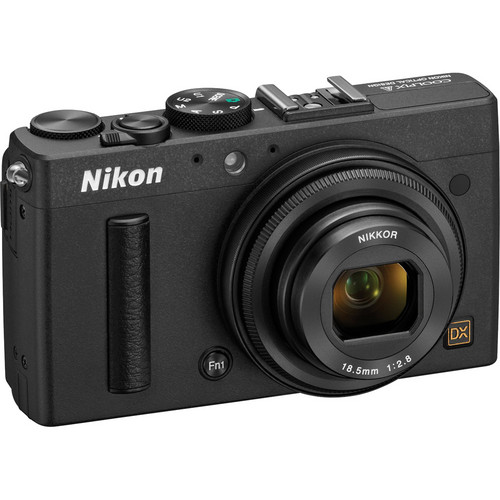
My eyes glisten – brain snaps into alert mode – eyes scan the specification and checks that it really does say that it has a ‘DX’ sensor. Thinks, with such a large sensor and Nikon technology, it will undoubtably make great images.
I check the rest of the specifications and see that it has a 28mm fixed f2.8 lens. That’s a bit limiting, but I can work within that limitation.
It’s small – the length is just a bit wider than the width of my hand. And it weighs 300g (11ounces)
I wonder how much it costs?
Ouch!
$1100 in the US £1,000 in the UK
No way, and ouch again.
Update: Size and weight comparison
Nikon A
111 x 64 x 40 mm (4.37 x 2.52 x 1.57″)
299g
Fuji x100s
127 x 74 x 54 mm (5 x 2.91 x 2.13″)
455g
Leica X2
124 x 69 x 52 mm (4.88 x 2.72 x 2.05″)
345g
Am sure the price will start sneaking down in a few months ….
LikeLike
You may be right. The price of the Nikon 1 series dropped dramatically, but the Nikon 1 series took a hammering in the photographic press.
The Nikon A may be a niche product because of its fixed 28mm wide-angle lens. And there may not be a lot of people willing to pay $1,100 for a fixed wide-angle lens camera.
LikeLike
So what does a DX sensor do??
LikeLike
It’s a large sensor – many times the area of that on a normal compact camera. Bigger sensors mean better quality images.
LikeLike
Well that makes sense!
LikeLike
If it is of interest – I wrote this guide to digital cameras with an explanation of the upside and downsides of large versus small sensors.
LikeLike
I will check it out. Thanks. I have so much to learn about my camera still.
LikeLike
Always happy to share what I know. What camera do you have, currently?
LikeLike
It’s a Nikon coolpix P7000. Most of the photos on my blog have been taken with it and I think they look pretty good but I do struggle with overexposure. Apart from the occasional crop or straighten I don’t do any photo editing.
LikeLike
I don’t know whether you do this or not, but I do use the exposure compensation dial on my cameras. The sensor is the camera has to decide what it is looking at, and it doesn’t always get it right. It gets it right more often with the dSLRs, but that’s not surprising because there is more room to put the electronics that calculates what the scene is that the camera is being pointed at.
LikeLike
I will look that up in my instruction book. Does that have anything to do with ISO?
LikeLike
ISO is different.
Your camera has got got an exposure compensation dial on the top plate.
It’s the dial on the right hand end of the top plate with numbers that go -3..-2—1– 0..+1..+2..+3
The default position is 0 (zero) and that’s where it should be for most scenes.
LikeLike
Oh yes, I know the dial you mean and I have played with it a bit. I find when it’s very glary I put it on -1 and it makes a big difference.
LikeLike
You can read about ISO in the article I mentioned.
LikeLike
It will be my mission on the weekend to read it and find out all about it. I’ll get back to you then!
LikeLike
🙂
LikeLike
Sounds good … in certain ways, but ..no. At least not now.
LikeLike
That is awefully expensive considering that a Nikon DSLR 5200 with 18-55mm VR lens cost about half of that, here in India. Is this the only coolpix with DX sensor?
LikeLike
I’m pretty sure it is the only Coolpix with a DX sensor that Nikon has ever made.
The only justification for it would be, say, a press photographer who needed a discrete camera for certain situations. Something like that, perhaps.
It is not the only compact on the market with a DX sensor. There are competitors such as the Leica X2, which is even more expensive.
There is also the Sigma DP2 that has a large sensor – but it has a Foveon lens arrangement, which seems to mean that there are fewer micro-lenses on the sensor.
And although not a compact, there is also the Fuji X100, which is bigger, but maybe not that much bigger. It’s hard to judge sometimes without seeing cameras side by side.
Then there is the Sony RX1, which is a compact and it has a full frame sensor – so even bigger than DX.
LikeLike
That was a lot of information. The price is for compactness. Sony RX1 would be more ouch-er, obviously. I think without learning the lighting correctly, camera really does not matter.
LikeLike
I agree that technique probably counts for much more than the camera for many photographers – and I include myself in this.
I would like to see some prints from a Micro 4/3 camera, the Coolpix A, and the full-frame RX1 to see how much of a difference there is.
It is simply not possible to judge from photos on the web.
I like review sites like DP Review that allow you download RAW files and process them.
LikeLike